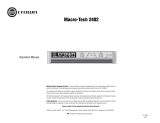
Circuit Theory 4-3
130446-1 Rev. A
MA-5002VZ Service Manual
©2000 Crown International, Inc.
full (negative) potential developed by the power sup-
ply.
The total effect is to deliver a peak to peak voltage to
the speaker load which is twice the (static) voltage pro-
duced by the power supply. Benefits include full utiliza-
tion of the power supply (it conducts current during both
halves of the output signal; conventional designs re-
quire two power supplies per channel, one positive and
one negative), and never exposing any output device
to more than half of the peak to peak output voltage
(which does occur in conventional designs).
4.2.2 Output Stage Circuitry
Circuitry on the positive and negative output modules
include bias circuitry, current limit circuitry, last voltage
amplifiers (LVAs), pre-drivers, drivers, output devices,
and the Low Side error amp. Temperature sensors are
also mounted to the heatsinks via the output modules.
The positive LVAs (Q501, Q502, and Q503) convert the
negative output of the voltage translator stage to a posi-
tive drive voltage for the NPN High Side (HS) predriver.
There are three LVA transistors in parallel due to the
very high voltages (therefore higher current and ther-
mal requirements) that are present when the power
supply is in high voltage mode. D522 prevents the +LVAs
from producing a high negative output to the HS NPN
stage.
Q507, Q508, and Q509 are the -LVAs and are arranged
in mirror image to the +LVAs, including D513.
On the positive side, D514, D515, and C506 via the
+LVAs act to limit slew rate. D514 and D515 also pre-
vent dangerously excessive current through the LVAs.
D516, D517, and C507 are the negative HS mirror im-
age.
Q534 and Q540 provide two-speed current limiting in
the output stage. Sense lines are arranged such that
excessive current through any single HS output device
will result in current limit protection. Q535 and Q541 are
the negative side mirror image.
Q505 on the positive output module works in tandem
with Q505 on the negative output module as a Vbe
multiplier circuit. They produce and, with great stability,
control bias for the High Side NPN and PNP devices.
Potentiometer R505 is used to precisely set bias volt-
age. Bias voltage is easily measured from pin 2 (hot) to
pin 4 of ATE ports TP1 and TP2. Refer to Section 2 for
appropriate test procedures.
Q504 is the HS NPN pre-driver and Q511 is the HS
NPN driver. These devices are biased class AB for ul-
tra low distortion in the zero-crossing region.
Q513, Q515, Q517, and Q536 are the HS NPN output
devices. These devices are biased class B, in soft cut-
off. Together with driver and pre-driver, they function as
a three-deep Darlington. The output devices work in
parallel as a giant composite. The over-all bias topol-
ogy is referred to as AB+B, originally conceived and
patented by Crown engineers in 1966. This is still the
most efficient, stable, and distortion free method used
today in BJT output stages.
D506 is the flyback diode for the HS NPN output quad-
rant. In the event that a back EMF (flyback) pulse ex-
ceeds power supply voltage, the flyback diode will shunt
this voltage to the supply in order to protect the output
devices.
PNP pre-drivers, drivers, output devices, and flyback
diode D508 are a mirror image of the NPN side.
Overall, the High Side of the bridge operates much like
a conventional output stage, but the Low Side (LS) is
quite unique.
The LS senses output voltage and common buss (0.04
ohms above ground) potential. The audio output is in-
verted by U503. Also in the U503 input circuitry are static
and dynamic balance controls. These controls provide
a fine balance of the grounded bridge. Output of the
op-amp drives the LS pre-driver circuits through the LS
bias network.
LS bias is controlled in a fashion similar to that of the
HS. Two transistors, Q529 and Q530, fix LS bias volt-
age as measured from pin 15 (hot) to pin 13 of appli-
cable ATE port TP1 or TP2. Potentiometer R556 adjusts
bias in the LS.
Diodes D504 and D505 control polarity of applied LS
drive signal. Via the bias transistors, signal is delivered
to the bases of the pre-drivers Q527 (NPN) and Q528
(PNP). Pre-drivers, drivers, and output devices in the
LS operate class AB+B, exactly like the HS. The major
difference is that rather than driving a load, the NPN
and PNP stages control the ground reference for the
high voltage rails. As the HS NPNs conduct, LS PNPs
conduct, and vice versa (as explained in section 4.2.1).
When the ODEP circuit senses that limiting drive is nec-
essary to prevent a dangerous thermal condition, it pro-
vides an output which limits drive to the output stages.
For the HS, this limiting is accomplished on the main
module and is explained in section 4.4. For the LS, ODEP
provides (via wires labeled ±LL) a signal which limits
bias feed to the LS output devices. This is accomplished
through current mirrors Q532 and Q531 (LS NPN quad-
rant), and Q542 and Q543 (LS PNP quadrant).

























